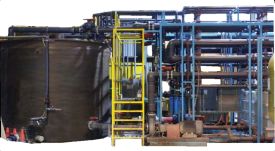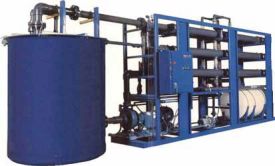Menu
Microfiltration Systems are designed to remove selected contaminants, including inorganic, organic, or heavy metals. This will meet or exceed regulatory compliance and/or water recycling objectives. Microfiltration systems provide nominal 0.2-micron filtration, require no polymer addition, and normally require less operation attention than a clarification system.
Our tubular crossflow microfiltration systems are a great Industrial Wastewater Treatment solution that is ideally suited as a pretreatment system for reverse osmosis water recycling systems.
A two-step process of Chemical Pre-Treatment and Microfiltration results in a more efficient and reliable system compared to conventional treatment methods. The first step, chemical pre-treatment, converts the contaminants to filterable particles, minimizing fouling. The second step, membrane microfiltration, physically separates the particles out of the water.

This step requires analysis of wastewater, and development of a customized chemical treatment process. Each process will be different depending on incoming wastewater and requirements for the resulting treated water. For an example the contaminants that clog reverse osmosis membranes may be removed by precipitation, adsorption, chemical reduction/oxidation, pH adjustment and microbial control, which may require two- or three-stage reactions. These reactions may include pH adjustment, coagulant addition, powdered activated carbon addition, softening, precipitant addition, or other processes.
Wastewater that has been pre-treated is then processed through a microfiltration system designed to separate the precipitates from the water. High velocity wastewater is pumped through a series of membrane modules. The turbulent flow produces parallel currents producing high-shear scrubbing which minimizes solid deposits on the membrane surface. Clear filtrates permeate through the membrane and the suspended solids are retained in the re-circulation loop and periodically removed for further de-watering. Physical surface cleaning is automatically done with low-pressure back-pulse mechanism reversing the filtrate flow direction.

Membrane cleaning is a routine part of most filtration systems and microfiltration is no different. Chemically pre-treated wastewater is recirculated from the concentration tank through one or more trains of membrane modules. The interior of the membrane tubes become coated with particles over time, decreasing the effective filtration. To keep the system functioning at its highest rate, Clean-In-Place is required. Clean-in-Place (CIP) technology works by circulating the cleaning solution (acids (H2SO4 or HCl), oxidizers (NaOCl or H2O2), and bases (NaOH)) through the modules or soaking the modules for an extended period if the fouling is severe.

Met-Chem, Inc.
837 East 79th St.
Cleveland, OH 44103
Phone: (216) 881-7900
Email: info@metchem.com
Copyright © Met-Chem, Inc